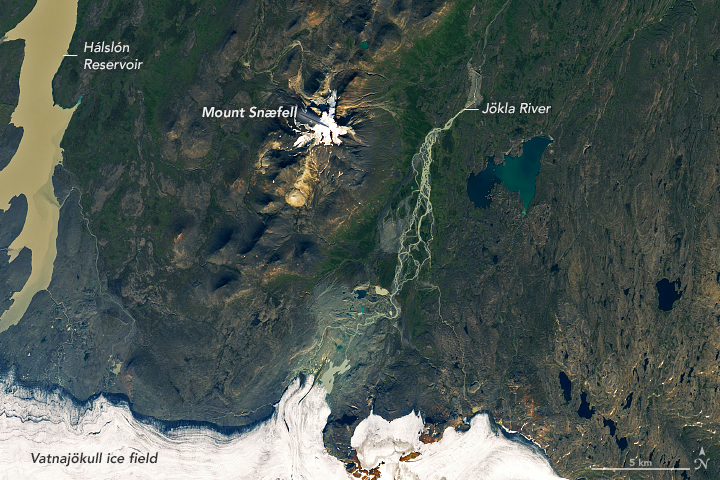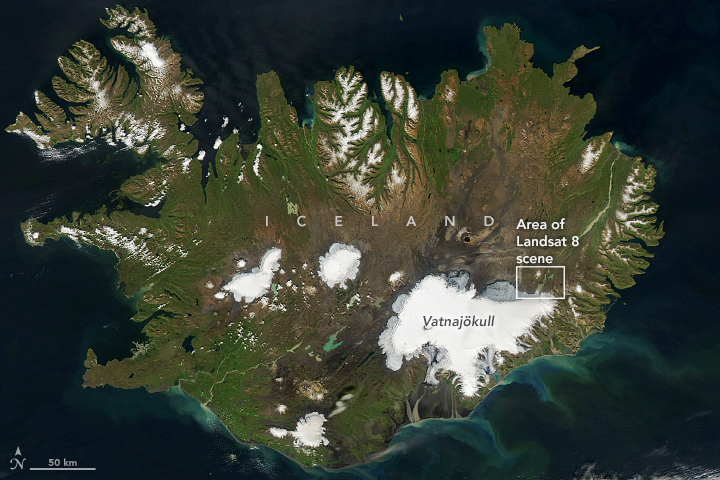
Grazing with Iceland’s Reindeer
Downloads
- icelandreindeer_oli_2021252_lrg.jpg (3915x3405, JPEG)
- iceland_amo_2020226_lrg.jpg (2645x1763, JPEG)
- reindeer.jpg (720x480, JPEG)
Metadata
- Sensor(s):
- Landsat 8 - OLI
- Aqua - MODIS
- Data Date: September 9, 2021
- Visualization Date: December 21, 2021
While most of the world’s populations of reindeer and caribou have declined significantly in recent decades, Iceland’s herd is doing fine. Its population grew rapidly in recent decades and is now stable.
Reindeer were first brought by royal decree from Norway to Iceland in the 1700s after diseases had killed about 60 percent of the island’s sheep population. Initially there was hope they could be domesticated and be kept on farms. But early efforts at reindeer husbandry fizzled due to the harsh winters, competition with sheep farmers, and lack of interest among Icelanders in raising the animals.
Nonetheless, wild reindeer thrived in East Iceland, an area with plenty of a key type of lichen (Cetraria islandica) for herds to consume. The population swelled from a few dozen reindeer in the 1700s to more than 5,000 now. Many of Iceland’s reindeer now spend much of their time in the summer foraging in the highlands near Mount Snæfell. When winter weather arrives, they descend into warmer valleys closer to the ocean.
The Operational Land Imager (OLI) on Landsat 8 captured this image of Mount Snæfell and the surrounding area on September 9, 2021. The Hálslón Reservoir lies to the west and the Vatnajökull ice field to the south. As seen in the second image, the highland plateau north and northeast of Vatnajökull glacier is the only place in Iceland with continuous vegetation from the seashore to Vatnajökull. That image was acquired by the Moderate Resolution Imaging Spectroradiometer (MODIS) on NASA’s Aqua satellite.

Limited grazing land can be a problem in Iceland due to the island’s long, cold winters. Satellite observations of vegetation—particularly a measure called the Normalized Difference Vegetation Index (NDVI)—are among the tools that researchers and wildlife managers use to monitor the health of pastures and reindeer populations in East Iceland.
Reindeer in East Iceland don’t have to contend with any natural predators, parasitic flies, or mosquitoes. To keep reindeer populations in check, human hunters are permitted to kill about 1000 - 1,300 of the animals each year.
“To prevent overgrazing, we keep the density of winter populations under one animal per square kilometer,” explained Skarphéðinn Þórisson of the East Iceland Nature Centre. “Most of the overgrazing that happens in Iceland is related to sheep farming—not reindeer—and happens mainly in areas other than East Iceland.”
References
- Circum Arctic Rangifer Monitoring and Assessment Network Iceland. Accessed December 21, 2021.
- East Iceland Sustainability Initiative (2021) Reindeer. Accessed December 21, 2021.
- Iceland Monitor (2021, January 26) Drive Slowly! Reindeer Crossing the Road! Accessed December 21, 2021.
- Iceland Magazine (2019, January 16) The story of the wild reindeer herds in the Eastfjords. Accessed December 21, 2021.
- Karlsdóttir, U. (2021) Progress or Mistake? The Introduction of Reindeer to Iceland. Nordic Journal for Eighteenth-Century Studies, 18.
- Möller, M. (2021) Reindeer in Space: Assessing the suitability of different satellite sensors to detect vegetation vulnerability to reindeer grazing patterns in East Iceland. Accessed December 21, 2021.
- Reykjavik Grapevine (2019, July 24) Ask An Expert: Why Are There No Reindeer In Western Iceland? Accessed December 21, 2021.
- Þórisson, S. (1984) The history of reindeer in Iceland and reindeer study 1979 — 1981. Rangifer, 4 (2).
- Þórisson, S. (2018) Population dynamics and demography of reindeer (Rangifer tarandus L.) on the East Iceland highland plateau 1940-2015: A comparative study of two herds. Accessed December 21, 2021.
NASA Earth Observatory image by Lauren Dauphin, using Landsat data from the U.S. Geological Survey and MODIS data from NASA EOSDIS LANCE and GIBS/Worldview. Photograph by Darcy Moore. Story by Adam Voiland.
This image record originally appeared on the Earth Observatory. Click here to view the full, original record.
